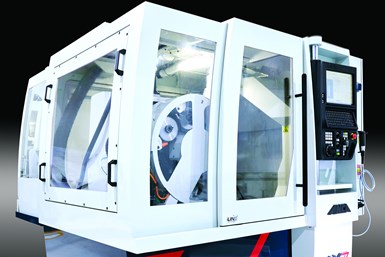ANCA Offers Grinding Machine for Manufacturing Cutting Tools
The new MX7 Ultra includes developments in the linear and rotary axis, tuning parameters, as well as several system enhancements and major mechanical changes.
ANCA’s new MX7 Ultra can manufacture large volumes of end mills and other cutting tools of high accuracy and quality. New software, hardware and design features advance surface finish, accuracy and controlled runout capabilities.
The MX7 Ultra includes a nanometer control system; a new servo control algorithm for smooth motion; system and mechanical upgrades enhance stiffness and rigidity; in-process measuring, balancing and runout compensation for consistent accuracy; Motor Temperature Control (MTC), which provides compensation for thermal expansion on the grinding spindle; and specialist training support.
To increase the stiffness of the C-axis, the MX7 Ultra combines developments to the nanometer or micro-degree resolution in the linear and rotary axis, tuning parameters, several system enhancements and major mechanical changes.
ANCA’s newly designed servo control algorithm enables smooth motion of an axis with the use of a unique algorithm and nanometer measurement in the control system. This reportedly creates finer cutting edges and eliminates micro-chips, making it more efficient while used in actual machining of materials.
The MX7 Ultra is said to provide better cycle time and higher productivity of high-quality cutting tools. Its unique algorithm is key to the performance of the machine and ensures outstanding tracking performance.
Cutting-edge software has been developed by ANCA to ensure batch consistency in large volumes. LaserUltra is part of the MX7 Ultra package to maintain consistency and accuracy of the grinding process, which includes in-process measurement and compensation to accommodate wheel wear and other external variations during large batch grinding. Its analog capability can maintain less than ±0.002 mm line-form accuracy of any profile which includes ballnose and corner radius tools.
Tool and wheel performance can be further optimized by the iBalance software, which guides users to the optimal grinding position and rpm for vibration monitoring and balancing the wheelpack inside the machine. Correctly balanced wheelpacks result in superior surface finish and reduced wheel wear due to the elimination of wheel vibration.
A major inclusion in the MX7 Ultra package is the total tool runout measurement and compensation operation in iGrind. Every tool in the batch can be measured and compensated for runout to make sure the entire batch is within a tolerance of 0.002 mm.
Motor Temperature Control (MTC) is a patented innovation built into the motor spindle drive firmware. Smart control algorithm actively manages and maintains the temperature of motorized spindles in the MX7 Ultra. Dramatically reduced machine warmup time means production can start sooner, once the machine has reached thermal stability. This improves productivity and machine use. Consistent thermal stability of the spindle over time regardless of changes in load or speed, or coolant temperature, greatly improves the dimensional stability of grinding results.
The smoother, finer cutting edge and surface finish as a result of the combination of all the above, including the nanometer control, will assist in all post-grinding applications like edge preparation and coating. A finer edge that has been properly prepared has greater stability, which reduces the likelihood of it chipping while also decreasing surface roughness, which can cause increased friction between the tool and the workpiece.
Related Content
Volumetric Accuracy Is Key to Machining James Webb Telescope
To meet the extreme tolerance of the telescope’s beryllium mirrors, the manufacturer had to rely on stable horizontal machining centers with a high degree of consistency volumetric accuracy.
Read MoreChoosing Your Carbide Grade: A Guide
Without an international standard for designating carbide grades or application ranges, users must rely on relative judgments and background knowledge for success.
Read MoreHow to Reduce Cycle Times by 70% and More on Your Existing CNCs and Dramatically Improve Tool Life Too
By employing advanced high efficiency milling techniques for the entire machining routine, SolidCAM’s iMachining technology can drastically reduce cycle times while vastly improving tool life compared to traditional milling.
Read MoreA New Milling 101: Milling Forces and Formulas
The forces involved in the milling process can be quantified, thus allowing mathematical tools to predict and control these forces. Formulas for calculating these forces accurately make it possible to optimize the quality of milling operations.
Read MoreRead Next
The Cut Scene: The Finer Details of Large-Format Machining
Small details and features can have an outsized impact on large parts, such as Barbco’s collapsible utility drill head.
Read More3 Mistakes That Cause CNC Programs to Fail
Despite enhancements to manufacturing technology, there are still issues today that can cause programs to fail. These failures can cause lost time, scrapped parts, damaged machines and even injured operators.
Read MoreObscure CNC Features That Can Help (or Hurt) You
You cannot begin to take advantage of an available feature if you do not know it exists. Conversely, you will not know how to avoid CNC features that may be detrimental to your process.
Read More



























